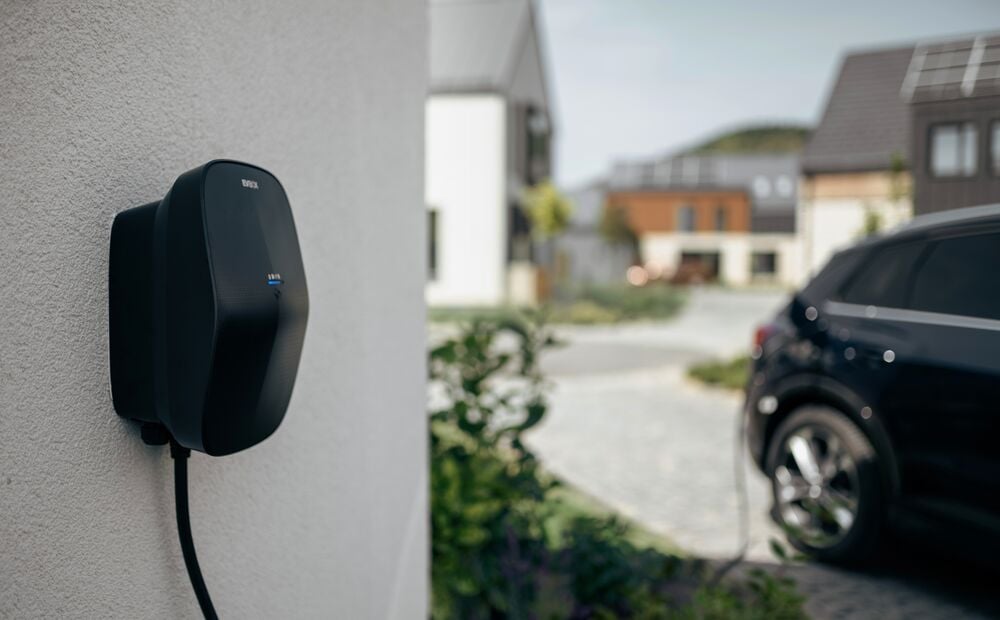
A typical home solar setup comprising of ten 300W panels that receive on average 6.02 hours of peak sunlight per day, produce about 13.5kWh of energy a day.
The average EV has a battery size of about 63kWh and consumes about 0.20 kilowatt-hour (kWh) per kilometer or 0.32 kWh per mile.
How often and how much you need to charge depends on how often and far you drive. The average American drives about 59.5 km (37 miles) a day. In Europe, this average differs per country but is, roughly speaking more than half of the daily distance driven in the US.
So, let’s say an average EV, driven by the average EV driver would use about 10% of a full charge each day. To replenish this charge using an average solar array in a country that receives 6.02 hours of peak sunlight per day would, therefore, take about 2.81 hours of solar EV charging.
As far as home EV charging goes, 2.81 hours of solar charging a day is pretty fast! Not to mention 100% renewable and 100% free.
Read our full article or jump down directly to:The rise of solar rooftops and home EV charging
As we move toward a greener world, an increasing number of homeowners have solar panels installed on their roofs, feeding their homes with 100% renewable and 100% free electricity.
What you might not have known is that these very same solar panel arrays can also be used to charge electric vehicles via your household AC charger. This is an especially important revelation when we consider that not only do the majority of EV drivers recharge their cars at home, but rising environmental concerns are one of the key motivators for potential EV buyers to make the switch to electric mobility.
One of the most accessible and effective ways to reduce your carbon footprint even further, as an EV owner, is to consider installing solar power at home, with which to recharge your car.
Naturally, however, before making the significant investment required to establish a residential solar array, you’ll probably want to know just how efficient solar EV charging is.
This article dives headfirst into one of the most important questions on EV drivers’ lips: How fast can you charge an EV using solar panels at home?
Solar panel EV charging: Getting to grips with the basics
Before we can get into the speeds associated with EV solar charging at home, it’s worth exploring the basics of how solar panels work.
When the semiconductor materials in solar panel cells are hit by sunlight, the energy from the light forces electrons to be displaced, in turn generating a current. This current (DC) is then amplified by technology built into the solar panel, before being stored in batteries or inverted to AC and fed directly into the household electricity supply, whereupon you can channel it through your EV home charger to recharge your car.
There are a number of different factors which can affect the amount of electricity your solar panels can produce. These include:
- The direction the solar panels face
- The angle at which the panels are tilted
- Obstruction of the panels (AKA ‘shading’)
- Type and quality of the panels
- Solar insolation and irradiation in your area
- Amount of sunlight the panels are exposed to at any given time
- Solar panel efficiency (25% loss in energy generated is standard)
- Maintenance of the panels
Many of these factors can vary wildly from day to day and hour to hour, which is why pairing solar panels with an energy management system (EMS) could be a good idea. An EMS combined with an EV home charger can help regulate and manage the peaks and troughs of solar energy output.

Calculating solar power generation
Working out how much electricity your current, or future solar panel array will generate depends a great deal on the variables mentioned above.
However, for the sake of our discussion on solar EV-charging speeds, let’s take a look at a sunny example.
We’ll use the example of a good quality 300W solar panel on a roof in sunny Mexico City, Mexico, which receives an average of 6.02 peak sun hours per day. Provided that this panel is tilted at the optimal angle, faces south toward the sun, is clean, unobstructed, and under direct sunlight, then we can expect it to work at its advertised efficiency of 25% (meaning that it generates around 75% of its full energy potential).
We can calculate the average output of this panel like so:
(Panel power rating) x (average peak sun hours) x (panel efficiency) = kWh generated per day
0.3kW x 6.02h/day x 0.75 = 1.35kWh/day per panel
In this example, therefore, a single 300W panel installed on a Mexico City rooftop would produce an average of 1.35kWh per day. If this 300W panel were to form part of a 10-panel array, we could then calculate that the array would generate 13.5kWh of free and green solar electricity each day.
Knowing how much energy your solar array can produce on average plays an important role when it comes to calculating how fast the array can recharge your EV. And since we don’t all live in Mexico City this differs depending on your location.
For example, In the US, the average daily sunshine hours in San Diego are 8.4 so using that same setup the average solar generation would be 18.9 kWh, whereas in New York the average is 6.9 hours of daily sunshine and it would lead to 15.5 kWh.
And in European cities like Amsterdam, Brussels, Paris, or Berlin the average daily sunshine hours are around 4.5 hours. If we use that same formula and setup, this will lead to a daily generation of solar power of 10.12 kWh.
In London, with only 3.8 average hours of sun per day, it would be 8.55 kWh.
Other appliances in your house use solar-generated electricity
The amount of solar energy you can use to charge your car does not only depend on the hours of sunlight.
Of course, other appliances in your home also run on electricity. For example, a microwave uses up about 0.14 kWh, an oven about 3,5 kWh, A television around 0.3 kWh, and having 5 lightbulbs on for 2 hours requires around 0.6 kWh. If these appliances are all using solar energy, that’s 4.5 kWh of solar energy not going into your vehicle. If you want to use your self-generated solar energy for your electric car, home energy management systems or smart charging station features can offer optimization.

Estimating charging times: Calculating how fast you can charge a car with solar panels
To calculate the approximate time it will take for your solar panel array to charge your car, you need the following figures:
- The average daily power output of your solar panel array [P1], as calculated above
- The power output setting(s) of your home AC charger [P2]
- The battery size of your EV [B1]
- Your average daily mileage [M1]
- Your car’s average energy consumption per mile/kilometer [M2]
- With these figures in hand, you can then determine how fast your solar panels will recharge your EV using a series of relatively simple equations.
For the below equations, we’ll use the following examples:
- P1 = 8,5 kWh per day, from the example of a London solar array
- B1 = 42kWh, that of a Fiat 500e
- M1 = 20 miles, a roughly average estimate of daily mileage covered by UK drivers
- M2 = 0.251kWh per mile, that of a Fiat 500e
Equation 1) How fast your solar array can fully-recharge your car
First, calculate the theoretical speed of a 0-100% solar EV recharge [SSOL] in days, using this equation:
SSOL = (B1/P1)
SSOL = (42/8.5)
SSOL = 4.94 days
We’ve now determined that to fully recharge a 42kWh Fiat 500e from 0-100% charge, using a solar array that generates on average 8,5 kWh per day, it would take nearly 5 days of charging using solar power only (when the sun is out).
This is obviously a long time and may not seem like much use to the average EV owner. However, most home-charge sessions do not require a 100% recharge. In fact, they tend instead to act as smaller top-ups after the short daily commute to and from work.
So, the next step is to determine your average required charge [RE], expressed as a decimal point of 1 with 1 being a 100% recharge. For example, a 20-80% recharge would be expressed as 0.6 (60%).

Equation 2) How much do you need to recharge your EV on an average day?
Calculate your average daily recharge requirements [RE] using the following equation:
RE = ((M1 x M2) / B1)
RE = ((20 x 0.251) / 42)
RE = (5.02 / 42)
RE = 0.12 (12%)
In this example, we’ve demonstrated that a Fiat 500e, after the average daily mileage used by a UK driver, would have depleted its battery by 12%. Thus, your average daily recharge requirement would be to top up your EV by 12%.
Equation 3) How fast solar power can recharge your EV to your determined RE
Finally, we can calculate how long it will take your solar array to top-up your EV battery on an average day [TSOL] by using the equation:
TSOL = (SSOL [in hours] x RE)
TSOL = (18.72 x 0.12)
TSOL = 2.25 hours of solar charging
Here, we have answered the question of how fast a solar array can recharge an EV to replenish the energy consumed during an average day of driving.
For a Fiat 500e driving 20 miles a day on average, recharged by a solar array producing 8.5 kWh of energy a day on average, the EV driver would need to recharge their car for 2.25 hours using the electricity from their solar panels.
Once we frame the speeds of solar EV charging like so, it becomes evident how practical and effective residential solar arrays can be for the average EV driver.
There are, of course, also other factors that can affect solar EV charging speed.

Solar EV charging: 5 factors which affect solar charging speeds for electric cars
We know for a fact that you can charge EVs using solar panels, but what factors determine how fast you can do so? Let’s take a look.
1) EV battery size
The number of kWh of electricity your car’s battery can hold. This is in effect the “100%-charged” marker. The bigger the battery, the more electricity required to fill it.
2) EV battery charging capacity
The capacity of your EV’s battery is the total amount of energy that can be stored in a battery in kWh. For example, whilst the Honda e can only receive up to 35.5kWh from a charger, the Audio e-tron GT quattro has a battery capacity of 93.4 kWh.
3) Charge requirement, or “state of charge”
The amount you need to recharge your EV, expressed as a percentage of its full battery size, according to how much electricity your car uses on a daily basis. For example, a common aim of EV owners is to recharge their vehicles to 80% charge whilst the car sits idle at home. If the car has been reduced to 50% charge during the day, then the “charge requirement” would be 30%.
4) Weather conditions
The colder the temperature outside, the poorer the batteries perform. This goes for your smartphone as much as it does your EV. Thus, whilst it’s hard to account for or calculate the impact of weather on charging, note that it will likely take longer to recharge an EV battery with solar in colder temperatures.
5) Home charger and solar array output
Lastly, the two main factors dictating how much energy you can charge your EV with are 1) the output of your home AC charger and 2) the output of your solar array.

If you wish to recharge your EV using solar power only, then you will be limited according to how much energy your panels produce each day (Energy is expressed in kW, and power is expressed in kWh) while turning off all other appliances in your home.
Equally, your AC charger will deliver a consistent wattage to your EV throughout the charge session, dictated by the AC charger’s capabilities.
Our latest home AC charger, for example, can deliver either 7.4kW, 11kW, or 22kW of electricity to your EV battery depending on the solar energy available to you, and your preferred settings.

Conclusion: is solar EV charging worth it?
Whilst some popular EV models could feasibly be recharged on a daily basis using solar power alone, with the peak sun hours available, others would require multiple days of solar EV charging to achieve the same effect.
Thankfully, you don’t always need to recharge solely using solar. Instead, a solar array can be used in conjunction with grid electricity to recharge your EV in a timelier fashion, whilst still saving you money on your utility bills and reducing your carbon footprint.
It is equally worth noting that you can increase the viability of your solar-powered EV home-charging setup by integrating battery storage, allowing you to use your renewable energy whenever you need to, rather than only during sunlight hours.
Hopefully, this guide to solar EV charging speeds has illustrated that solar panel charging is a cost-saving, effective, and sustainable means of recharging your EV. To continue learning more on the topic of home solar EV charging, head to our blog.
Related articles

Smart Charging for Solar EV Systems: What is possible today?
There are a variety of smart solutions available, capable of optimizing your solar EV charging system in different...

Can solar EV charging save you money?
Charging your EV using household solar panels can indeed save you money on your utility bills. How much money solar EV...

How to optimize your solar set-up for charging electric cars at home
There are several ways EV drivers can optimize a homegrown solar system to ensure their EV recharging needs are met....
-min.jpeg?width=640&height=427&name=MicrosoftTeams-image%20(1)-min.jpeg)